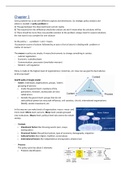Chapter 1
Every problem has to do with different aspects and dimensions. So strategic policy analysis and
advice is needed. A policy problem is:
A) The gap between the ideal world and current reality
B) The reason(s) for this difference should be unclear; we don’t know what the solutions will be
C) There should be more than one possible solution to the problem; always look for several solutions;
the real word is too complex for one solution
So the policy = a problem + end + means
‘A purposive course of actions followed by an actor of set of actors in dealing with problem or
matter of concern’.
The means in policy are simple; 4 means/instruments to change something in society:
- Judicial: legalization
- Economic: subsidies/taxes
- Communication: persuasion (overhalen mensen)
- Modern: self-regulation
Policy is made at the highest level of organizations; ministries, etc. How can we give the best advices
to this top level?
Health policy triangle model
- Actors: individuals, organizations, groups, ‘states’;
grouping of persons
o Inside the government: members of the
parliament, ministers, bureaucrats are also
called actors
o Outside the government: groups that do not
seek political power but may seek influence; civil societies, church, international organisations
(WHO), socials movements, etc.
In this way we can make levels of organization: macro- meso- and
micro-level. Micro-level: persons. Meso-level: people grouped
into institutions. Macro-level: political level who steers the whole
society.
- Context:
o Situational factors like focusing events (war, coups,
earthquakes)
o Structural factors like political system, type of economy, demography, migration
o Cultural factors like religion, tradition, social values
o International factors like independence among states, bilateral aid
- Process:
The policy cycle has about 5 elements
o Problem identification
Pagina 1 van 15
, o Policy formulation; analyzing what the problem is, what are the ins and outs, and what will
the solution be?
o Policy implementation; the decisions have to be implemented in the world
o Policy evaluation; look back, how did it go?
- Content:
o What is it all about?; numbers, experiences, what is the issue?, what is the difficult part?, why
is it not working?
o Do interviews, set up focus groups, etc.
Chapter 10; doing policy analysis
Two types of analysis exist:
- Retrospective analysis: learning from the past, look backwards, compare cases, analysis OF
policy
- Prospective analysis: advising the present, analysis FOR policy → change and reform, looking up
evaluation reports, what went wrong and needs to be changed?
One of the most important steps is stakeholder analysis; who are the actors, what are they doing,
and how do they influence? So identify the actors, asses the power of their relationships, asses their
interests, position and commitment, and asses the opposition (power).
You need to set up strategies. Develop political strategies for policy change. You need to have the
knowledge about the risk that you take, you need to have the proper background information, you
need access to decision makers and media, you need to have funds, personnel and facilities, you
need to have knowledge about the costs, and about your public relationship (a patient position will
play the act of a victim, a political party will play the role of hero, etc.).
All the data that is available is large; you have to focus it down to the specific information that will be
meaningful. Be efficient in time; think twice. Check the literature of experts. Look for best practices
and analogies. And finally; ask key players, the opposition (they can bring other information;
interesting). This really makes the change.
Some tips are;
Don’t believe your sources. You have to be very critical. Understand from what perspective the
information has been written. Understand the interest of the writer. Ask for evidence in an interview
(what is the article that supports this idea?). Check the info by 2 or 3 sources (literature,
observations, blogs, etc.). Try to be convinced by the information; be decisive about where the data
came from. Look at the tables and graphs, not at the conclusion! What was the population (elderly,
women, country)?
Who are we looking for to follow/contact when we want to make a change?
Results from research, issue analysis, studies.
When we know our actors, and we know the issues that we want to change, we did the analysis. We
know we have only limited options for actions we can take. We are going to look which actor may be
interested in legal change, or in economic change, or educational. Industry is very interested in tax
Pagina 2 van 15






